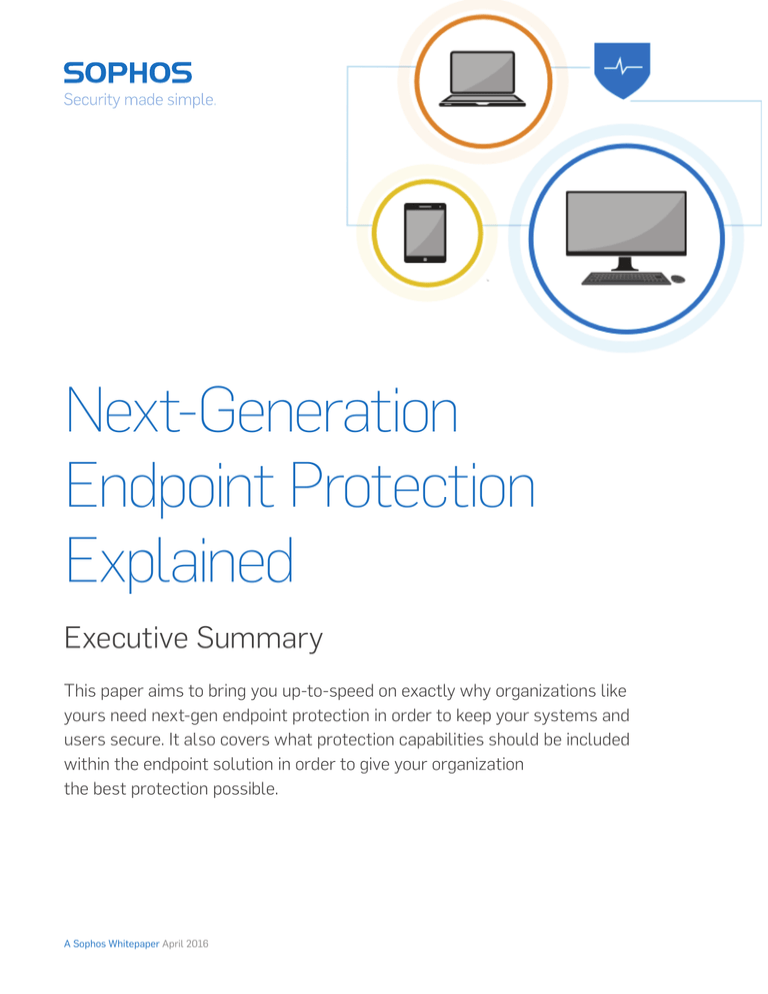
Next-Generation
Endpoint Protection
Explained
Executive Summary
This paper aims to bring you up-to-speed on exactly why organizations like
yours need next-gen endpoint protection in order to keep your systems and
users secure. It also covers what protection capabilities should be included
within the endpoint solution in order to give your organization
the best protection possible.
A Sophos Whitepaper April 2016
Next-Generation Endpoint Protection Explained
The evolving threat landscape
Advanced Persistent Threats (APTs) and malware attacks are unfortunately a constant
source of news headlines. Recent examples include the Hollywood Presbyterian
Medical Center that was forced to pay a $17,000 Bitcoin ransom after their files were
encrypted; elsewhere in Germany patient care has been affected with hospitals hit by
file encrypting ransomware; and the Melrose police department in Massachusetts was
forced to pay a 1 Bitcoin ransom to regain access to their files.
Furthermore, a study by the ISACA found that 33% of organizations are not confident
that they are prepared to deal with an event triggered by APTs1 .
A study by the
ISACA found
that 33% of
organizations are
not confident that
they are prepared to
deal with an event
triggered by APTs1
Cyber Snipers At Work
Advanced Persistent Threats Uncovered
1 Advanced Persistent Threats (APTs)
APTs are usually targeted at specific industries,
organizations, or even individuals and may involve
significant research into personnel, offices,
IT practices, operations, and much more
to help gain a foot-hold
Command & Control
Server
3 Discretely
Call Home
The infected
system connects
to the command &
control (C&C)
server for further
instructions or to
start passing
sensitive data
2 Entry Point
Targeted or not, the
initial system is usually
infected by either:
• Visiting an infected website
• Opening an email attachment
• Plugging in a USB stick
4 Covertly Spread
The malware may choose to remain
undetected and move slowly or it
may attempt to spread to other
systems by taking advantage of
unpatched vulnerabilities or using
hijacked credentials
5 Silently Exfiltrate Data
The malware may attempt to steal information from emails, documents,
Skype or IM conversations, or even webcams depending on its intentions
A Sophos Whitepaper April 2016
2
Next-Generation Endpoint Protection Explained
The best defense against the threat of APTs is a strong endpoint that makes use of a
range of different prevention techniques to ensure that nothing slips through the net.
Increasingly this is being supplemented by a coordinated security setup, where multiple
solutions communicate to share contextual information meaning faster detection and
an automated response.
What should organizations expect from a nextgen endpoint solution?
Protection is at the heart of a next-gen endpoint solution and organizations should look
for advanced technologies that protect against all stages of an attack:
1. Prevention: Stopping malware before it can execute
2. Detection: Identifying quickly when malware is deployed
3. Response: Taking action instantly when malware is detected
However advanced protection capabilities alone are not enough. For a next-gen endpoint
solution to be effective in the real world it should keep users secure without slowing
them down, while also being simple by design so organizations can actually put in place
the protection they need.
Let’s now explore the protection technologies in more detail.
Prevention – The defensive frontline
Prevention focuses on stopping malware from ever reaching the device in the first place,
eliminating the opportunity for it to establish itself.
Your endpoint solution should contain the following:
Exposure Prevention
Pre-Execution defense
Web protection
Device control
File analytics/HIPS
Emulator
Are webpages known
to be malicious, do
they contain suspect
content
Which devices (e.g. USB
drives) are allowed to
access the endpoint
Examining the
components/structure
of the file, does it
contain code trying to
modify the registry
Execute the
suspect file in a safe
environment for testing
purposes
Download reputation
Signatures
Where does the file originate, who created it, is it in
use on other machines in the organization
Rapidly identify known malware
A Sophos Whitepaper April 2016
3
Next-Generation Endpoint Protection Explained
Detection – Catching malware in the act
Detection uses a variety of methods to identify malware that has reached a device and
conclude what action should be taken.
Look out for these features:
Runtime behaviors
Malicious traffic detection
Memory scanning
Are processes communicating
with known threat locations
(“phoning home”)
Is the suspect file exhibiting
behavior patterns of known
malware
Exploit detection
Is the suspect process cataloging the memory of another process,
is it injecting itself into the machine
Response – Clean up and further analysis
The response section focuses on effective eradication of the malware, ensuring the
endpoint is secure and performing analysis to identify the entry point of the malware.
Malware removal
Root cause analysis
Take out the executable and
other components of the
malware
Identify the originating cause
of the malware to better
understand what may have
been compromised
A Sophos Whitepaper April 2016
4
Next-Generation Endpoint Protection Explained
APTs Vs the Endpoint
Now let’s take a look at how a typical APT in the wild would attempt to infect a system
and which next-gen endpoint capability should be present and active in each of these
stages.
The APT attempts to gain access to the device in order to take further action
Exposure
•
Device controls restrict what can access the endpoint, e.g. blocking access to USB and external hard-drives
•
Web protection checks whether web pages are known to be malicious
•
Download reputation checks who created the file, where does it originate from and are other machines in the
organization using it
The APT searches for vulnerabilities on the device that it can use to embed itself
Exploit
•
Application lockdown only allows approved applications to be installed and run on the device
•
Web protection checks whether web pages are known to be malicious
The APT looks to deliver its payload onto the device
Delivery
•
Sandbox emulation runs the suspicious file in a safe environment so that it can be tested
•
File analytics/HIPS examine the components and structure of the file to see whether it contains code trying to
modify the registry
Signature detection is used to rapidly catch previously identified malware
•
Now on the device, the APT attempts to start executing
Persistence
•
Exploit detection checks if the suspect process is cataloging the memory of other processes and whether it is
injecting itself into the device
•
Web protection checks whether web pages are known to be malicious
•
By this point most traditional types of malware should already have been detected and removed
The APT is now up and running and working to achieve its objectives
Act on
objectives
•
Behavior analytics examine the suspect file to see if it exhibits the patterns of known malware
(aka memory scanning)
•
Synchronized Security enables the endpoint and network to share information regarding the threat. Response
is coordinated and automated, for example the data from the firewall will allow the endpoint to identify and
isolate the compromised device. At which point automated cleanup kicks in
Now fully established, the APT is now free to communicate home
Command &
Control
A Sophos Whitepaper April 2016
•
Malicious traffic detection searches for processes that are communicating with known threat locations
•
Network lockdown isolates compromised devices from the network so they can't spread the infection
5
Next-Generation Endpoint Protection Explained
Individual solutions, or coordinated security?
Organizations can choose to deploy next-gen endpoint protection in two ways: as an
integrated solution that includes protection, detection and remediation capabilities,
or as a complex mesh of technologies requiring manual integration and interaction to
correlate and prioritize alerts.
The main challenge posed by the manually integrated approach is that it requires
manual intervention to analyze the data from the individual solutions and coordinate the
response.
For many mid-size organizations dedicating resource towards, or even finding the
required expertise for IT security is an up-hill struggle.
As the graph below shows, the top reason for disappointment with security technology
purchases is down to a lack of in-house security expertise.
(Source: Ponemon Institute 2015, 2015 Global Study on IT Security Spending & Investments)
Furthermore the ISACA states:
“Current practitioners lack the requisite skills to leverage the technology; understand
the threat; and integrate cybersecurity risk management strategies, tools and policies
to defend against the APT.2 ”
Unfortunately many current and even next-gen endpoint protection solutions are
doing little to address these issues. While competent in their own right, they are found
wanting when it comes to giving organizations coordinated prevention, detection and
response to increasingly more coordinated attacks.
A Sophos Whitepaper April 2016
6
Next-Generation Endpoint Protection Explained
For an under-resourced IT team this lack of coordinated security can mean the
difference between catching a critical alert and a compromised system.
And even for enterprise-sized IT teams security systems that don’t share information
can lead to duplicated alerts, additional time spent tracking down an intrusion and a
plethora of different management consoles for each solution.
Now more than ever before, security solutions need to be a permanent member of the
team, not just a tool.
Introducing Sophos Next-Gen Endpoint
Protection
Sophos Next-Gen Endpoint Protection integrates innovative security technologies to
protect against all stages of an attack, coordinated through a central control engine.
The result: outstanding protection against malware and advanced threats for your
Windows, Mac and Linux systems.
•
Includes advanced threat protection, behavioral analysis, host intrusion prevention,
web security, malicious traffic detection, anti-malware and more
•
Prevents infection, detects compromised systems and remediates threats with
real-time threat intelligence from SophosLabs
•
Blocks malicious URLs and web exploit code
•
Identifies and stops endpoint communication with attackers’ servers
•
Analyzes pre- and post-execution behavior to detect previously unknown
malware
•
Delivers web, application, and device control, all managed through the intuitive
central management tool.
Additionally, Sophos Security Heartbeat™ enables Sophos Next-Gen Endpoint
Protection to share contextual information in real-time with Sophos Next-Gen Firewall.
This synchronized security approach delivers unparalleled protection against advanced
threats and also significantly reduces incident response time.
Next-gen endpoint security technology is only useful if you can actually use it. That’s
why Sophos Next-Gen Endpoint Protection is engineered to be simple to configure,
deploy and manage. It also delivers lightning performance so customers can enjoy
maximum protection with minimum impact – on users and IT managers alike.
A Sophos Whitepaper April 2016
7
Next-Generation Endpoint Protection Explained
Conclusion
The need for security has never been more prevalent yet the skills and resources
available seem ever more sparse. Sophos provides a simple to implement, simple
to manage and effective alternative to the complex world of point product security.
Organizations should investigate the benefits of a single endpoint agent providing
prevention, detection and response capabilities and develop a synchronized security
strategy to better protect and respond to security incidents.
References
ISACA 2015, 2015 Advanced Persistent Threat Awareness – Third Annual
1
ISACA 2015, 2015 Advanced Persistent Threat Awareness – Third Annual
2
Sophos Next-Gen
Endpoint Protection
Visit Sophos.com/endpoint
for a 30-day free trial
United Kingdom and Worldwide Sales
Tel: +44 (0)8447 671131
Email: sales@sophos.com
North American Sales
Toll Free: 1-866-866-2802
Email: nasales@sophos.com
Oxford, UK | Boston, USA
© Copyright 2016. Sophos Ltd. All rights reserved.
Registered in England and Wales No. 2096520, The Pentagon, Abingdon Science Park, Abingdon, OX14 3YP, UK
Sophos is the registered trademark of Sophos Ltd. All other product and company names mentioned are
trademarks or registered trademarks of their respective owners.
2016-04-11 WP-NA (MP)
Australia and New Zealand Sales
Tel: +61 2 9409 9100
Email: sales@sophos.com.au
Asia Sales
Tel: +65 62244168
Email: salesasia@sophos.com



